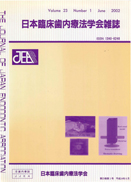21 巻, 1 号
選択された号の論文の7件中1~7を表示しています
- |<
- <
- 1
- >
- >|
原著
-
2000 年 21 巻 1 号 p. 1-7
発行日: 2000年
公開日: 2019/01/31
PDF形式でダウンロード (4990K) -
2000 年 21 巻 1 号 p. 8-11
発行日: 2000年
公開日: 2019/01/31
PDF形式でダウンロード (1894K) -
2000 年 21 巻 1 号 p. 12-16
発行日: 2000年
公開日: 2019/01/31
PDF形式でダウンロード (3901K) -
2000 年 21 巻 1 号 p. 17-22
発行日: 2000年
公開日: 2019/01/31
PDF形式でダウンロード (3949K)
ケースレポート
-
2000 年 21 巻 1 号 p. 39-42
発行日: 2000年
公開日: 2019/01/31
PDF形式でダウンロード (2486K) -
2000 年 21 巻 1 号 p. 43-47
発行日: 2000年
公開日: 2019/01/31
PDF形式でダウンロード (2891K)
メディカルエッセイ
-
2000 年 21 巻 1 号 p. 48-52
発行日: 2000年
公開日: 2019/01/31
PDF形式でダウンロード (4837K)
- |<
- <
- 1
- >
- >|
